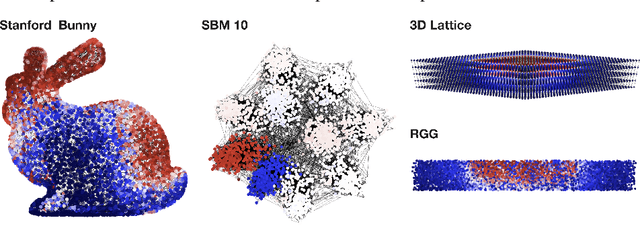Jianzhi Long
PointWavelet: Learning in Spectral Domain for 3D Point Cloud Analysis
Feb 10, 2023Abstract:With recent success of deep learning in 2D visual recognition, deep learning-based 3D point cloud analysis has received increasing attention from the community, especially due to the rapid development of autonomous driving technologies. However, most existing methods directly learn point features in the spatial domain, leaving the local structures in the spectral domain poorly investigated. In this paper, we introduce a new method, PointWavelet, to explore local graphs in the spectral domain via a learnable graph wavelet transform. Specifically, we first introduce the graph wavelet transform to form multi-scale spectral graph convolution to learn effective local structural representations. To avoid the time-consuming spectral decomposition, we then devise a learnable graph wavelet transform, which significantly accelerates the overall training process. Extensive experiments on four popular point cloud datasets, ModelNet40, ScanObjectNN, ShapeNet-Part, and S3DIS, demonstrate the effectiveness of the proposed method on point cloud classification and segmentation.
Localizing Scan Targets from Human Pose for Autonomous Lung Ultrasound Imaging
Dec 15, 2022Abstract:Ultrasound is progressing toward becoming an affordable and versatile solution to medical imaging. With the advent of COVID-19 global pandemic, there is a need to fully automate ultrasound imaging as it requires trained operators in close proximity to patients for long period of time. In this work, we investigate the important yet seldom-studied problem of scan target localization, under the setting of lung ultrasound imaging. We propose a purely vision-based, data driven method that incorporates learning-based computer vision techniques. We combine a human pose estimation model with a specially designed regression model to predict the lung ultrasound scan targets, and deploy multiview stereo vision to enhance the consistency of 3D target localization. While related works mostly focus on phantom experiments, we collect data from 30 human subjects for testing. Our method attains an accuracy level of 15.52 (9.47) mm for probe positioning and 4.32 (3.69){\deg} for probe orientation, with a success rate above 80% under an error threshold of 25mm for all scan targets. Moreover, our approach can serve as a general solution to other types of ultrasound modalities. The code for implementation has been released.
Faster Optimization on Sparse Graphs via Neural Reparametrization
May 26, 2022



Abstract:In mathematical optimization, second-order Newton's methods generally converge faster than first-order methods, but they require the inverse of the Hessian, hence are computationally expensive. However, we discover that on sparse graphs, graph neural networks (GNN) can implement an efficient Quasi-Newton method that can speed up optimization by a factor of 10-100x. Our method, neural reparametrization, modifies the optimization parameters as the output of a GNN to reshape the optimization landscape. Using a precomputed Hessian as the propagation rule, the GNN can effectively utilize the second-order information, reaching a similar effect as adaptive gradient methods. As our method solves optimization through architecture design, it can be used in conjunction with any optimizers such as Adam and RMSProp. We show the application of our method on scientifically relevant problems including heat diffusion, synchronization and persistent homology.
 Add to Chrome
Add to Chrome Add to Firefox
Add to Firefox Add to Edge
Add to Edge